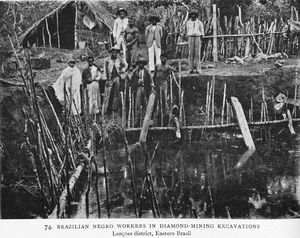
With mine officials nearby, Brazilian slaves wash the gravel from riverbeds to concentrate the denser minerals in which diamonds are found. Dependency on slave labor was an unfortunate part of early diamond mining in Brazil. "Diamond washing in Brazil." Published in 1884.
When diamonds were discovered by alluvial gold miners in Brazil in 1725, Indian diamond sources were near exhaustion and European demand for the stone continued unabated. From 1730 to 1870 Brazil was the world's major source of diamonds. Indeed, mining in Brazil was so active that by the late 1730s production far exceeded demand, and diamond prices fell by as much as 70%. Beginning in 1850, production rose again, following the discovery of rich deposits in Bahia, but after 1861 it rapidly declined as deposits were depleted, leading to a great shortage of rough diamonds in the European cutting centers in the late 1860s. (source: American Museum of Natural History)

Slaves Diamond Mining in the Serro Frio Region, Minas Gerais, Brazil
"Diamonds in Brazil"-- Until 1725, India was the world's only producer of diamonds. In that year, Brazilian natives tasked with washing sand as part of the gold panning process discovered the precious stones, prompting the Portuguese government to move the gold mining industry out en masse to make way for diamonds.
J. Willard Hershey, writing in his comprehensive history The Book of Diamonds, tells us that for the first few years after diamonds were discovered in Brazil, the Portuguese government allowed a few plantation owners to work the land for diamonds using slave labor. By the 1740s, the system had changed and contractors – usually in charge of teams of some 600 slaves – would receive exclusive rights to the diamonds in the land they were working. Most contractors sold the majority of their diamonds to the Portuguese crown.

In the second half of the 18th century, more diamond discoveries extended Brazil's diamond fields from Diamantia (formerly Tejuco, where the stones were first found) to Bahia in the north, Goyaz in the west, and Matto Grasso in the jungle.
As Brazilian diamonds began to infiltrate the European market, owners of Indian diamonds feared a glut that would devalue their own stones and began to spread erroneous rumors that Brazilian diamonds were inferior in quality. In fact, Brazilian diamonds – while small, averaging 1/4 to 1/2 carats – can match the quality of diamonds found anywhere, and have often been noted for their rich color. Brazil is also the only known source for black or carbonado diamonds.
Diamond Mining, Brazil, ca. 1770s
In 1772, the Portuguese government took over the diamond mining sector from the contractors, to no great success. In 1822, Brazil gained its independence and anyone who could afford to pay taxes was allowed to mine for diamonds. Slavery, however, was still legal and slaves did nearly all the actual diamond mining. Any slave who found a diamond was required to alert the overseer immediately. If the diamond was over 17 carats, the slave was handed not only his freedom, but the right to hunt for diamonds for himself. Slaves who found smaller diamonds were more modestly rewarded.
Slaves washing diamonds, Brazil
In 1818, Brazil's total diamond production stood at 3,240,000 carats. By 1850, the South American nation had produced some 10,000,000 carats. But in succeeding years, diamond production waned, and in 2009, according to the Kimberley Process Annual Global Summary, Brazil produced only 21,000 carats of rough diamonds valued at $830,000. (source: http://www.avipaz.com/DiamondsBrazil)

Thanks for your good Post
ReplyDeletehttp://www.livestreamsportshd.com/
This comment has been removed by a blog administrator.
ReplyDeleteThis comment has been removed by a blog administrator.
ReplyDeleteThis comment has been removed by a blog administrator.
ReplyDelete